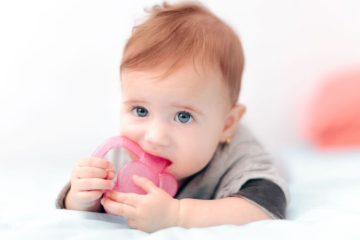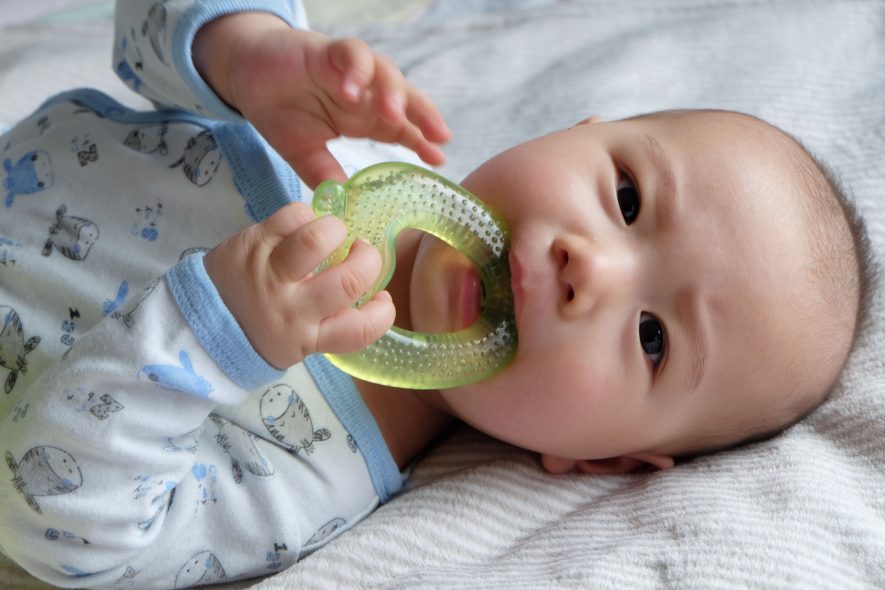
Is your baby more irritable than usual, or are they chewing their toys more than they are playing with them? These are telltale signs your baby could be teething and might need your help. Fortunately, there is a solution: a silicone teether.
Here are some ways a silicone teether can help your baby and why you should get one ASAP!
First: Is My Baby Teething?
At six months old, anything could be happening to your baby. The physical and mental challenges of getting older are innumerable for babies at that age, so how certain are you that what’s happening to them—if they’re in pain or not eating—is baby teething? If you’re unsure, here are some signs that could be baby teething symptoms.Drooling
Drooling is a common sign of teething. Because of emerging teeth, excess saliva covers the gums to soothe your baby. As long as you clean your baby’s mouth regularly, you should have no problem with drooling, as it is common among infants.
However, if the wiping isn’t enough, you could always get a teether for your baby.
Facial Rash
A rash on your baby’s face, particularly in the mouth area, could be another sign of baby teething because of the bacteria and fungi that come with saliva. To avoid facial rashes, you must wipe your baby’s mouth regularly. If it’s really bad, consider getting a baby toothbrush to clean your baby’s mouth.
Wakefulness
A teething baby is a sleepless baby. If your baby struggles with teething, especially during the first few weeks, they might have trouble sleeping. If your baby constantly wakes up at night, they could be hurting from the emerging teeth.
When your baby wakes you up in the middle of the night, stay calm and soothe your crying child. Eventually, it will pass.
Mood Changes
Teething can also make your child very irritable and stubborn, which could mean they are experiencing serious discomfort in their mouths. It could be because of teething if your baby is more irritable or highly emotional than normal. Older babies are much more likely to express their distress through their mood.
Excessive Biting
Biting is one way a teething baby relieves the pain of teething. If your baby bites you or objects around them randomly, it may not be because they’re playful. Instead, they could be in great pain.
If you don’t yet have teething toys, try giving your baby a soft cloth or your fingers to chew on. As long as you give them clean substitutes for teethers, there shouldn’t be a problem.
Holding Their Cheeks
Another way your baby can express the physical pain they feel from teething could be by holding the affected area. Since teething mainly affects the gums, their cheeks could be the first body part their hands land on. Take it as their way of telling you where it hurts.
Loss of Appetite
A loss of appetite, a common symptom of teething, could mean many things. Since teething involves the gums, mealtime could be difficult for your baby, especially if they begin weaning. However, the possibility of your baby not eating because of teething is still very real.
Gum Bruises
If you suspect your baby to be teething but aren’t showing any physical signs or symptoms, they could be hurting from the inside. It could be a gum bruise if you spot a dark or black area in the gums.
Gum bruises happen when emerging teeth push up and, in the process, damage their gums. Regularly check your baby’s mouth for signs of any diseases so you can prevent them from becoming worse.
![]()
Will a Silicone Baby Teether Help My Child?
Absolutely. Silicone baby teethers aren’t just a means of soothing your child at the moment; when used correctly, a silicone teether can also be beneficial for their development in the long run. Here are some specific ways silicone baby teething toys can be great for your baby.
Soothes Gums
Baby teething can be painful, and much of the pain comes from activity in the gums. To relieve themselves of the pain, your baby puts pressure on their tender gums by biting and chewing the first thing they grab—they consider it soothing.
It’s one of the reasons why baby brands design baby teething products the way they are. Whether it’s teething rings or necklaces, they’re for your baby to grip and bite on as they please.
Bonus Tip: many parents have found success in leaving teething toys in the fridge to cool. Allowing your baby to chew on them could relieve them from gum pain.
However, while refrigerating silicone teethers can be great for your baby, we strongly advise against putting the toy in the freezer since it could become too hard and hurt your baby.
Improves Mood
Soothing your teething babies’ sore gums with a multipurpose teether can also positively affect their mental health since the toys alleviate the psychological distress caused by teething.
With the right teething toy at your baby’s side, expect them to sleep longer, have quality rest, and smile more. And who wouldn’t want an adorable baby to be happy?
Helps Improve Jaw Muscles
Teething toys will be one of the first exercises for your baby’s underdeveloped mouth. Chewing and biting teethers can be great practice for your baby since it puts the mouth and jaw muscles under stress.
Improving your baby’s oral motor early on will make their lives easier since much of their development will revolve around eating and speaking.
Baby Weaning Aid
Teethers can also help a lot concerning baby weaning since teething toys provide babies with different textures to experience. Such textures will be important when they are introduced to solid foods, as they have already experienced chewing and biting into solid things.
Later, get your baby a high chair, too, and make their first meal memorable!

Are Baby Teething Toys Safe?
Yes, they are. There is nothing wrong with using baby teething toys as long as they are made from baby-safe materials. The UK’s National Health Service even recommends using baby teething toys for children.
Here are some safe materials to make baby gear with:
- Food-grade silicone
- BPA-free plastic or silicone
- PVC-free plastic or silicone
- Wood
- Lead-free plastic
On the other hand, here are some unsafe materials:
- Any materials that include BPA, lead, PVC, or phthalates
- Any plastic or silicone that is not food-grade
- Homeopathic gels
Homeopathic Gels
Homeopathic gels are gels designed for pain relief. However, there have been many reports about the danger of using homeopathic gels on children, including a variety of illnesses like difficulty breathing, diarrhea, lethargy, and so on.
When buying things your baby ingests, it’s important to research the material and whether or not it’s gained the approval of many doctors. Otherwise, it’s not worth risking your baby’s safety.
How Do I Clean the Silicone Teether?
It’s common knowledge that silicone teethers spend loads of time exposed to germs and bacteria. Fortunately, silicone teethers are pretty easy to clean.
Silicone teethers are dishwasher-safe; you just have to chuck them into the dishwasher and let the machine do the rest. If you want to hand wash them, that’s fine, too. Remember not to leave teethers uncleaned for too long, even when you have spares, since used teethers have a high chance of developing mould on the surface.
Looking for Fun Teethers? Try Ashtonbee’s Fruit-Shaped Teether for Your Baby
Raising a child can sometimes be overwhelming, but remember: having fun is always important. That’s why we recommend trying out Ashtonbee’s fruit-shaped baby teethers for a few smiles to go along with soothing your baby’s sore gums. Buy your baby one now and be a part of our Ashtonbee family!



